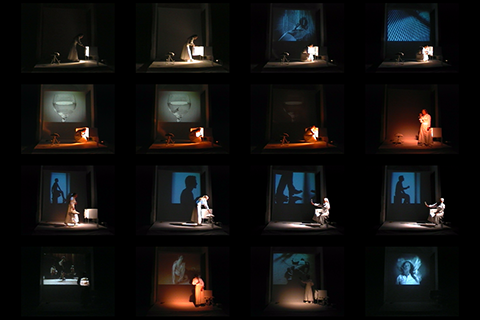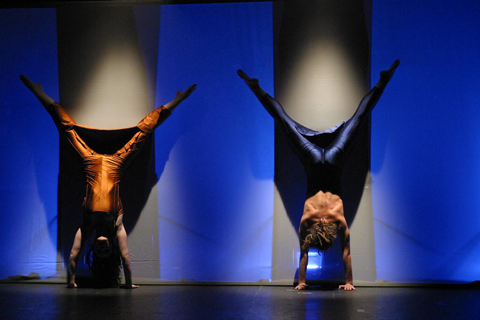A Three-Step Guide to Clearing Rights

Title: Yes nurse, no nurse (Ja zuster, nee zuster). Ep. 15; Cast
From collection: Sound & Vision. License: CC BY-SA
The ECLAP Working Groups gathered on November 14 at the Stage Heritage at Your Fingertips event, which took place at the National Theatre Museum of Slovenia in Ljubljana. The e-library for performing arts ECLAP is a best practice network that brings together performing arts content from a diverse range of institutions in Europe. One of the objectives of the event was to get input from workshop attendees about the best practice guidelines that ECLAP released.
A big challenge that is facing performing arts organisations that want to provide online access to their holdings, is that they are often unsure how to determine the rights status of these collections, and how to clear rights. The working group on IPR and Business Models for Performing Arts Content asked attendees to provide input for a new addition on the best practice guide: a three-step guide to clearing rights, which had been presented in the morning session of the event. Questions such as "how do you approach rights clearance?" and "how does this fit in the three steps presented?" were laid out for them to respond to. The answers were diverse, but most importantly candid and they provided a great deal of relevant information for the further development of the ECLAP guidelines.
 Title: Scene from the performance Interiere No. 1. Creator: Peter Uhan.
Title: Scene from the performance Interiere No. 1. Creator: Peter Uhan.
From collection: MUZEUM. License: CC BY-NC-ND
Round table
Each attendee was asked how they are currently providing access to their collections, how they approach rights holders to clear rights, which types of agreements they make and licenses they provide. The outcomes were as follows and are divided among the first axis of the three-step process: what type of access do you (aim to) provide? The outcomes were:
- Restricted access: 3 attendees stated they provide restricted access to collections, namely for educational users only. Also, UNIROMA has opted to provide restricted online access to orphan works, with a disclaimer in which people can find contact info if they are rights holders and want to claim their rights. These rights were cleared by making individual agreements with the rights holders (e.g. directors, performers, editors).
- Public access: 3 other attendees (Ljubljana Puppet Theatre, ESMAE, Cankarjev dom) provide public access to content, which means that users can view, but not re-use it. Again, in order to obtain permission they had made individual agreements about showing content online.
- Embedding: Nobody made special agreements for allowing end users to embed content on third-party websites. Therefore, it was recommended to make sure that creators agree with having their content embedded in third-party websites and this make this option explicitly part and parcel of any agreement you make in which public or open access is provided.
- Open access: Surprisingly, 4 attendees had experience with Creative Commons licenses, besides offering restricted and public access. In all four cases, the organisations had opted to use the most restrictive Creative Commons license, which allows downloading and sharing, but does not permit making new works of the content, or commercial use (CC BY-NC-ND). Bruno Pereira from ESMAE highlighted that it is not that problematic getting 'open' permissions from rights holders for newly created content, but that the issue lies with older collections, since tracking down people and getting permission takes a lot of time. Now, the ESMAE students that create content sign a contract that states we get the rights for showing content online. This agreement allows ESMAE to use the CC BY-NC-ND license. Sudeshna Guha shared that the University of Cambridge’s standard license choice is CC BY-NC-ND. However, they also use it for some Public Domain content, since we don’t want everyone to just be able to re-use the materials. For instance, some pictures are from Aboriginal tribes, and there can be moral issues with specific kinds of re-use for this type of content. The National Theatre Museum of Slovenia’s in-house photographer, who makes pictures of performances there, has agreed that these pictures can be used under the CC BY-NC-ND license.
 Title: Scene from the performance Sirene (No. 4). Creator: Miha Fras.
Title: Scene from the performance Sirene (No. 4). Creator: Miha Fras.
From collection: MUZEUM. License: CC BY-NC-ND.
General conclusions
Grey areas: The term “grey area” was mentioned a lot by the workshop attendees. Many organisations often make choices to provide access to content, even if they are unsure whether all rights have been cleared. Opting for providing restricted access for educational users only is not in all cases legally sound, since there are no exceptions in copyright law for providing online access to content of educational purposes. Secondly, it can be hard or even impossible to check if a user indeeds belongs to an educational user group. Many times, you’ll just have to assume that this is the case.
Open up, increase impact: It was clear that many organisations see the benefit of using open licenses, since they facilitate easy re-use across different platforms. This does not just apply to end users, but for organisations themselves as well. This is a vital part of the recommendation of WG-B: clear rights once as generically and as open as possible, so that re-use conditions are clear and an organisation can distribute the same content on multiple platforms without having to ask for permission each time. However, truly ‘open’ access would also allow people to for instance make new works based on the content. This is why open platforms like Wikipedia only accept the two least restrictive Creative Commons licenses, namely Attribution (attributing the creator(s)), and Attribution Share-Alike (when you make a derivative work, attribute the creator and share the new work under the same license). So, even though the choice for CC BY-NC-ND is already a great step, when possible, opting for even less restrictive open licenses can further increase the reach and impact of access to collections.
Keep the Public Domain healthy: It is problematic that some content providers do not mark public domain material content as such, because they do not want to lose control of the content. This goes against the WG-B (and also: Europeana) recommendation to keep the public domain healthy. What falls in the Public Domain should stay in the Public Domain. This is best done by using the Public Domain Mark. This way, everyone can easily find performing arts heritage that they can freely access and re-use.
Be as generic as possible: While wrapping up, all attendees agreed that when making new agreements with rights holders, it is vital to make them as generic as possible. Although this might cost more time and convincing initially, in the end you save time because you don’t have to go back to the rights holders when there’s a new platform on which you want to provide access to content. Keep in mind that generic does not mean that you should not explicitly describe what types of re-use you will allow - the key is to describe and cover as many types of re-use on all types of platforms (online, offline, on-site) as possble.
IPR is a personal matter: A final note was that clearing rights is more often than not a very personal experience. No-one except workshop host Sound & Vision and project lead DSI had experience with large-scale umbrella agreements with Collective Management Organisations. Instead, rights holders had been approached individually by the organisations to sign agreements. The reason for this is that trust and knowledge of collections by organisations are key in getting rights holders on board when asking them to allow for online access to their work.
The coming month-and-a-half, Working Group B will further develop and specify the IPR clearance guidelines presented in Ljubljana. Thanks to the input by the workshop attendees, we have plenty more food for thought!
Participants
ECLAP partners:
- Marina Mazzotti (FIFF)
- Amparo Écija (UCLM)
- Raffaella Santucci (UNIROMA/CTA)
- Bruno Pereira (ESMAE)
- Sudeshna Guha (UCAM)
- Lotte Belice Baltussen (S&V, workshop chair)
- Paolo Nesi (DSI, ECLAP project coordinator)
External attendees:
- Primož Jesenko (National Theatre Museum of Slovenia)
- Kornelia Rorman (Cankarjev dom)
- Lidija Franjić (Ljubljana Puppet Theatre)
Colophon & disclaimer
- This post originally appeared on the eclap blog, 26 November 2012.
- Please note that this blog post does not serve as legal advice. Always consult a legal expert when undertaking a rights clearance process.
More info
- For Dutch residents: see this Sound & Vision overview of IPR issues in the Netherlands
- See the EUscreen list of relevant sources on IPR
